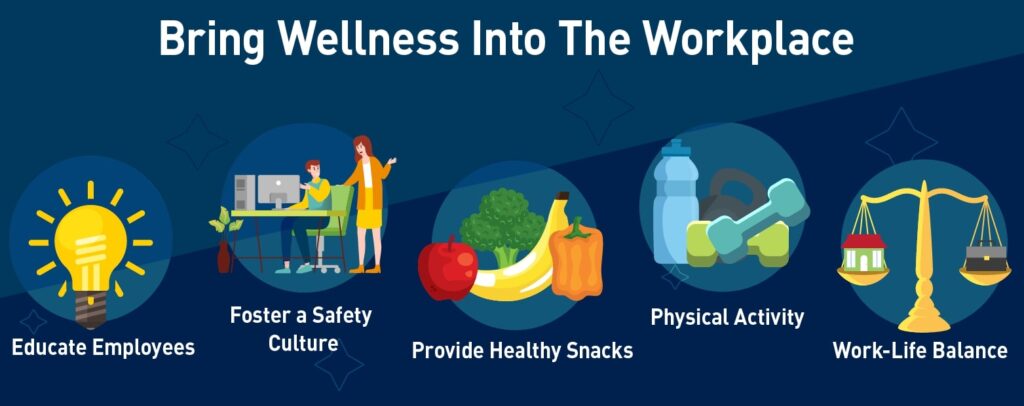Creating a Culture of Wellness
In recent decades, workplace safety has been a top priority for many organizations, resulting in a significant decrease in worker injuries, illnesses and deaths. While safety is still paramount, the idea of employee wellness has expanded beyond their physical health to encompass areas like worksite wellness and mental wellness — emphasizing the importance of a healthier workforce. This is especially true after the pandemic, which saw mental health symptoms spike in workers, affecting nearly a quarter of U.S. adults in 2021. Today, the idea of “financial wellness” has also become commonplace as rising inflation and economic uncertainty fuel fears for employees.
So how can employers develop workplace wellness programs that address all aspects of employee well-being? Here’s everything you need to know about creating effective strategies to promote workplace wellness.
More Than Morale
To start us off, it’s important to define what “workplace wellness” is exactly. Traditionally, people tend to think of “wellness” as a person’s physical health. While this is a crucial component, it’s not the full picture. Workplace wellness initiatives need to go beyond just safety and health care to support employees in all aspects of their lives, fostering a culture that promotes both physical and employee mental health.
In a nutshell, you can think of workplace wellness as consisting of six areas of someone’s life, including:
- Physical Health:
Physical health is often what you first think of when it comes to overall wellness. This dimension includes recognizing the need for things like a healthy diet, regular physical activity, a healthy sleep schedule, etc. For some employees, this might also include managing a chronic disease or health condition.
- Mental Health:
Mental or emotional health is another key aspect of overall wellness — and an area in which employees increasingly demand support. According to the American Psychological Association, over 90% of employees agree that mental health is a high priority while only 45% believe their workplace lives up to their emotional well-being goals.
- Social Connectedness:
While many are quick to lump social wellness into mental health, the two are distinct from one another but still closely related. Without a support network in their personal and professional lives, employees will be left feeling isolated and alone. In fact, almost 40% of employees feel lonely at work according to CuraLinc.
- Financial Well-being:
Financial wellness, not to be confused with financial stability, refers to when an individual feels in control of their personal finances with clear goals and steps to achieve them. This area of wellness has become especially important recently, as almost 60% of employees say finances are the No. 1 cause of stress in their lives, per a PwC report.
- Vocational Wellness:
Vocational wellness, also known as occupational wellness, is when an employee feels satisfied, engaged and fulfilled by the work they do. Moreover, occupational well-being requires a safe work environment and a supportive company culture. While this area is often the most overlooked, it’s also the one place employers have the most control.
- Sense of Purpose:
Finally, the last major dimension of wellness is finding a sense of purpose. Some people may find personal significance and satisfaction in what they do, but around 71% of employees don’t report they don’t have meaningful work. Of course, work isn’t the only place people find their purpose, so it’s more a matter of empowering employees to find their own and pursue it.
Why Is Workplace Wellness Important?
After seeing all the dimensions of holistic wellness laid out like that, it’s easy to feel a little intimidated. Some employers might even wonder how a few of these aspects are even their responsibility. Of course, achieving true wellness requires effort from both employees and employers, but the benefits of doing so are clear:
For Employees
Employees are obviously the ones who benefit most directly from a workplace wellness program. In addition to promoting a healthy lifestyle, these corporate wellness initiatives often involve fun and engaging activities, challenges, events and other perks that help the worker. Some programs even offer incentives around certain healthcare benefits, such as biometric screenings and preventative care, allowing employees to keep track of their overall health.
For Employers
On the other hand, employers have the potential to reap a slew of benefits downstream. Not only are workplace wellness programs great for boosting employee engagement, job satisfaction and retention, but they can also help organizations save around 25% on healthcare costs, workers’ compensation and disability claims, and absenteeism.

How to Bring Wellness Into the Workplace
Now that we understand what workplace well-being really is and why it matters, it’s time to find out how you can develop your own employee wellness strategies to support all aspects of your workers’ lives.
Here are 8 steps you can take to bring wellness perks into your workplace:
1. Educate Employees
The best place to start with any wellness initiative is effective communication. For a corporate wellness program, that means educating workers on wellness topics through workshops, seminars or even just group meetings. Topics can range from safety and nutrition to mindfulness and stress management. The idea is to get them talking about wellness and learning about what goes into a culture of well-being, thereby promoting healthier habits and behavior.
2. Foster a Culture of Wellness
Speaking of company culture, it’s also essential to start from the ground up, incorporating workplace wellness into the fabric of the company itself. Focus on creating an inclusive and supportive work environment where wellness is an integral part of the organization’s core values. Leadership should encourage open discussions and recognize achievements toward wellness goals to enhance the workplace culture.
3. Encourage Physical Activity
While you don’t want employees weightlifting in the office, it’s crucial for employers to encourage regular physical activity throughout the day. This might take the form of short walks, group fitness breaks or just promoting more movement. Some employers might even offer physical wellness perks like a gym membership or yoga classes, contributing to an overall healthier workforce.
4. Provide Healthy Snacks
Of course, exercise isn’t everything. It’s also about what we put in our bodies. Stocking communal areas with nutritious snacks, such as fresh fruits, vegetables, nuts or granola bars, is a great way to encourage healthy eating habits. Companies can also consider sponsoring Lunch & Learn sessions, in which employees get to eat and learn about preparing healthy foods, fostering healthy behavior.
5. Promote a Healthy Work-Life Balance
One of the most essential aspects of workplace wellness is a healthy work-life balance. While not every employer will be able to offer flexible hours or remote or hybrid work arrangements, they can still support employees in maintaining a balance. For example, don’t send that email past working hours and encourage employees to set similar boundaries to prevent burnout and support mental wellness.
6. Offer Volunteer Days
Volunteering can be a great way for employees to boost their mental health and find a sense of purpose. Allocating paid time off for volunteering days each year empowers your employees to make new social connections while giving back to their communities.
7. Host Group Activities
Team-building activities and social events are two other crucial parts of any corporate wellness program. Not only does it build community and foster collaboration, but it also offers a fun break from daily grind. Recreational activities like sports, classes, or even just walks allow employees to bond in ways they wouldn’t when just focused on work, enhancing employee well-being.
8. Hold Wellness Challenges
Similarly, a wellness challenge is a great health promotion tactic, and an excellent way to introduce some fun and competition into your wellness program. These can include things like step-tracking competitions for physical wellness, or meditation challenges for mental health. The opportunities are truly limitless, so get creative!
Best Practices for Implementing a Workplace Wellness Program
Before we close out, it’s important to cover one last thing: how to actually implement a workplace wellness program. While the process will look slightly different for each organization, as every company and corporate wellness program will be unique, there are a few general best practices to follow:
- Create a Wellness Team
First, you’ll need to assemble a diverse team to help design, implement and oversee your new workplace wellness program. Include people from across various departments to ensure you get diverse perspectives and expertise. Then, you’ll need to define specific roles, establish your wellness goals and continue aligning program strategies around organizational objectives and employee needs.
- Draft a Workplace Wellness Plan
As you get further into development, you’ll need to outline a concrete plan for the next year. This will include goals, activities, timelines and budget allocations. As part of this stage, you’ll also want to identify the key performance indicators you’ll be tracking to measure success, as well as how you’ll go about monitoring and evaluating these metrics.
- Establish Effective Communication
As your employee wellness program starts to pick up momentum, it will be crucial to have an effective communication strategy in place. This will ensure all employees are informed about the program, its incentives and any requirements that come with it. Your communication strategy should utilize multiple channels to connect with all team members, and it should also include clear steps for employees to provide feedback. This will help foster a more inclusive workplace culture.
- Incentivize Employee Engagement
One easy way to help ensure your wellness program is effective is to incentivize employee participation. Whether offering monetary rewards, recognition or other kinds of prizes, these incentives can significantly boost motivation and satisfaction, driving sustained engagement and contributing to a more productive and engaged workforce.
- Stay Informed on Wellness Topics
Finally, it’s essential to stay up to date on workplace wellness trends. Continuous education on the latest industry research, reports, web events and best practices will help ensure you stay abreast with all topics related to employee wellbeing. Moreover, you’ll be able to utilize these insights in your own wellness program as you make adjustments and optimize it based on performance and feedback, ensuring it remains a valuable wellness benefit for all employees.
Want More Wellness Tips?
If you’re looking for more workplace wellness tips, we’ve got you covered with this webcast on how to start a cost-effective wellness program webcast.






























